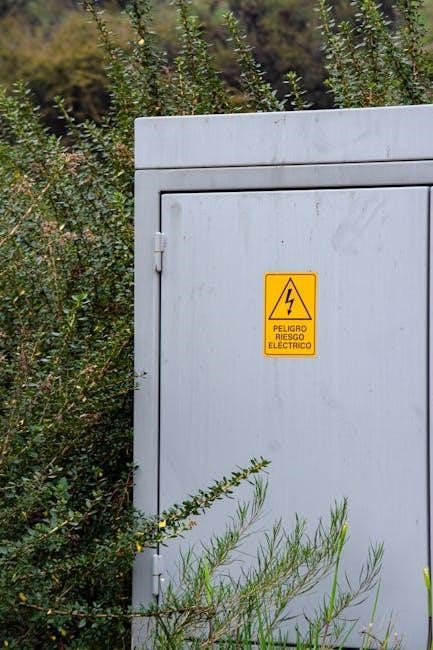Electrical connections are critical for safe and efficient power distribution. Proper connections ensure reliability, durability, and safety in various applications, from residential to industrial settings. Understanding different types of electrical connections, such as Western, T-Joint, Twisted, and End-to-End, is essential for maintaining electrical systems effectively. This guide explores their significance, types, and best practices for installation and maintenance.
Overview of Electrical Connections
Electrical connections are fundamental components in power distribution systems, ensuring the safe and efficient transfer of electrical energy. They involve joining conductors to maintain continuity and reliability in circuits. Various types, such as Western, T-Joint, Twisted, and End-to-End connections, are used based on specific requirements. These connections are crucial for residential, industrial, and high-voltage applications, providing durable and secure links between wires and devices. Proper installation ensures minimal resistance, reduces the risk of faults, and guarantees long-term performance. Understanding the principles and applications of electrical connections is essential for maintaining safety and efficiency in electrical systems.
Importance of Proper Electrical Connections
Proper electrical connections are vital for ensuring safety, reliability, and efficiency in electrical systems. Incorrect or poorly executed connections can lead to short circuits, overheating, and potential fires, posing significant risks to people and property. Reliable connections minimize electrical resistance, ensuring consistent power supply and preventing equipment damage. They also reduce the likelihood of electrical hazards and extend the lifespan of wiring and devices. Proper connections are essential for maintaining system performance, avoiding costly repairs, and ensuring compliance with safety standards. By prioritizing correct techniques and materials, electrical connections contribute to a safer and more durable installation.

Types of Electrical Connections
Electrical connections vary in design and application, ensuring reliable power distribution. Common types include Western, T-Joint, Twisted, and End-to-End connections, each suited for specific wiring needs.
Western Connection
The Western Connection is a widely used electrical connection type, known for its durability and mechanical strength. It involves twisting the wires together and securing them with a unique configuration. This connection is suitable for both indoor and outdoor applications due to its resistance to environmental factors. The Western Connection is commonly used in residential settings for its simplicity and effectiveness in ensuring reliable power distribution. It is preferred for its ability to withstand mechanical stress and provide a secure electrical bond. This connection type is essential for maintaining safety and efficiency in various electrical systems, making it a popular choice among electricians and technicians.
T-Joint Connection
The T-Joint Connection is a versatile and widely used method for branching power from one wire to another. It is ideal for applications where a new circuit or device needs to be connected without cutting the main wire. This connection type is particularly useful in residential and industrial settings, offering a reliable way to distribute electricity efficiently. The T-Joint Connection is known for its simplicity and effectiveness, making it a preferred choice for electricians. Proper insulation and secure fastening are crucial to ensure safety and prevent short circuits. This connection type is essential for maintaining flexibility and reliability in electrical systems, making it a cornerstone of modern wiring solutions.
Twisted Connection
The Twisted Connection is a simple and effective method for joining two or more wires together. This technique involves twisting the bare ends of the wires to create a secure mechanical bond. It is commonly used for temporary connections or in situations where space is limited. The Twisted Connection is easy to implement and requires minimal tools, making it a popular choice for quick repairs or installations. However, it is not recommended for high-voltage applications or environments with excessive mechanical stress. Proper insulation is essential to prevent short circuits and ensure safety. This connection type is ideal for low-voltage residential applications, offering a reliable and straightforward solution for electricians and DIY enthusiasts alike.
End-to-End Connection
The End-to-End Connection is a straightforward method used to join two wires by connecting their ends. This technique is commonly employed when extending the length of a wire or connecting two separate circuits. The wires are stripped at their ends and then securely attached using connectors or soldering. This connection type is durable and provides a reliable electrical path, making it suitable for both residential and industrial applications. Proper insulation is crucial to prevent short circuits and ensure safety. The End-to-End Connection is a versatile solution for maintaining continuity in electrical systems, offering ease of installation and long-term performance. Regular inspections are recommended to maintain its integrity and functionality over time.

Safety Considerations in Electrical Connections
Safety in electrical connections is crucial to prevent hazards. Proper insulation, secure connections, and adherence to standards are essential to avoid short circuits and ensure reliable operation. Always use appropriate tools and materials to maintain safety and durability in all electrical setups. Regular inspections and maintenance are vital to uphold safety standards and prevent potential risks associated with electrical systems. Following best practices ensures the integrity and longevity of connections, protecting both people and equipment from electrical hazards. Proper training and adherence to safety protocols are fundamental for safe electrical work. Understanding environmental factors and their impact on connections is also critical for maintaining safety in various applications. By prioritizing safety, electrical connections remain efficient and secure, minimizing risks and ensuring optimal performance over time.
Materials and Tools Required
For safe and reliable electrical connections, specific materials and tools are essential. Wire strippers, pliers, screwdrivers, and cable cutters are necessary for preparing and handling wires. High-quality connectors, terminals, and insulating tapes ensure secure and durable connections. Heat shrink tubing and soldering equipment are also used for added protection and strength. Proper insulation materials, such as PVC or rubber sleeves, prevent short circuits and electrical hazards. Using the right tools and materials is critical to maintain safety, efficiency, and longevity in electrical systems. Always choose materials that meet local electrical standards and are suitable for the specific application. Regularly inspect tools and materials to ensure they remain in good condition for safe and effective use.
Environmental Factors Affecting Connections
Environmental factors significantly impact the performance and durability of electrical connections. Moisture, humidity, and exposure to chemicals can cause corrosion and weaken connections over time. Temperature fluctuations may lead to thermal expansion and contraction, potentially loosening connections. Additionally, extreme weather conditions, such as heavy rain or high winds, can damage outdoor electrical systems. In industrial settings, dust and pollutants may accumulate on connections, disrupting conductivity. Understanding these environmental influences is crucial for selecting appropriate materials and ensuring long-term reliability. Proper sealing, insulation, and regular maintenance are essential to mitigate these effects and maintain safe and efficient electrical connections in various environments.
Best Practices for Safe Connections
Ensuring safe electrical connections requires adherence to best practices. Always use high-quality materials and tools suitable for the specific connection type. Proper insulation and shielding are essential to prevent short circuits and electrical hazards. Following established standards, such as those from the International Electrotechnical Commission (IEC) or National Electric Code (NEC), is critical. Regular inspection of connections for wear or damage is recommended to maintain safety. Additionally, de-energizing circuits before working on them and using insulated tools can prevent accidents. Proper tightening of connections and avoiding overloading are also key to ensuring long-term reliability and safety in electrical systems.

Applications of Electrical Connections
Electrical connections are vital in residential, industrial, and high-voltage systems. They power homes, factories, and infrastructure, ensuring reliable energy distribution and supporting modern technological advancements efficiently.
Residential Applications
In residential settings, electrical connections are essential for powering homes. Common types include Western, T-Joint, and Twisted connections, ensuring safe and reliable energy distribution. These connections support lighting, appliances, and entertainment systems, enhancing daily comfort. Proper installation of these connections in homes is crucial for safety, durability, and efficiency. They are often used in wiring circuits, extensions, and repairs, making them indispensable for modern living. By understanding and applying these connection types, homeowners can maintain secure and efficient electrical systems, preventing hazards and ensuring continuous power supply.
Industrial Applications
In industrial settings, electrical connections play a vital role in powering machinery and systems. Types like Western, T-Joint, and Twisted connections are widely used for their durability and reliability. These connections support high-voltage and high-current applications, ensuring smooth operations in factories and plants. They are often employed in motor controls, power distribution panels, and heavy machinery. Properly installed industrial connections minimize downtime, enhance safety, and optimize energy efficiency. Their robust design withstands harsh environments, making them ideal for demanding industrial conditions. By utilizing these connection types, industries can maintain consistent production and reduce the risk of electrical failures.
High-Voltage Applications
High-voltage electrical connections are essential for power transmission and distribution systems. These connections are designed to handle large currents and voltages without failing, ensuring reliable energy supply. Types like Western and Twisted connections are commonly used in high-voltage applications due to their durability and resistance to electrical stress. They are employed in power substations, transmission lines, and industrial grids. High-voltage connections require specialized materials, such as heat-resistant PVC or silicone cables, to prevent overheating and ensure safety. Regular inspections and maintenance are critical to avoid faults and ensure continuous operation. These connections are vital for powering large-scale infrastructure and supporting modern electrical demands effectively.

Tools and Materials for Electrical Connections
Essential tools include wire strippers, pliers, and screwdrivers. Materials like heat-resistant PVC cables, silicone wires, and insulation tapes ensure safe and durable connections. Safety gear is crucial.
Necessary Tools for Electrical Work
Essential tools for electrical work include wire strippers, pliers, screwdrivers, and crimping tools. Multimeters and cable testers ensure circuit accuracy and safety. Insulated gloves, goggles, and voltage testers protect workers from electrical hazards. Toolkits often feature punches, drills, and wrenches for diverse tasks. Heat guns are used for shrinking tubing and soldering. Torches and soldering irons are vital for precise connections. Cable ties and clips organize wires, preventing damage. Toolboxes and storage cases keep equipment tidy and accessible. These tools ensure efficient, safe, and professional electrical connections, whether for installations, repairs, or maintenance.
Materials Used in Electrical Connections
Key materials for electrical connections include high-quality wires, cables, connectors, terminals, and insulation. Wires and cables vary in gauge and insulation type, ensuring suitability for different voltage and current requirements. Connectors and terminals, such as screw, crimp, or solder types, securely fasten wires. Insulation materials like PVC, rubber, or Teflon protect against heat, moisture, and abrasion. Heat-shrink tubing and electrical tape are used for added protection and sealing. These materials ensure safe, efficient, and durable connections, preventing electrical hazards and maintaining system performance. Proper selection of materials is crucial for reliability in residential, industrial, and high-voltage applications.
Understanding electrical connections is vital for ensuring safety, efficiency, and durability in electrical systems. Various types of connections, such as Western, T-Joint, and Twisted, serve specific purposes and applications. Proper materials, tools, and techniques are essential to prevent hazards and maintain system performance. By mastering these connections, individuals can ensure reliable power distribution across residential, industrial, and high-voltage settings. This knowledge not only enhances electrical system functionality but also minimizes risks, making it a cornerstone of modern electrical practices.
Comments